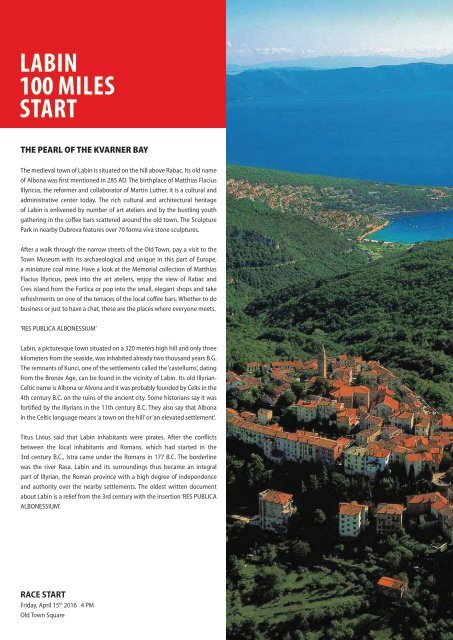RACE GUIDE
2rgNrkeZe
2rgNrkeZe
Create successful ePaper yourself
Turn your PDF publications into a flip-book with our unique Google optimized e-Paper software.
LABIN<br />
100 MILES<br />
START<br />
THE PEARL OF THE KVARNER BAY<br />
The medieval town of Labin is situated on the hill above Rabac. Its old name<br />
of Albona was first mentioned in 285 AD. The birthplace of Matthias Flacius<br />
Illyricus, the reformer and collaborator of Martin Luther, it is a cultural and<br />
administrative center today. The rich cultural and architectural heritage<br />
of Labin is enlivened by number of art ateliers and by the bustling youth<br />
gathering in the coffee bars scattered around the old town. The Sculpture<br />
Park in nearby Dubrova features over 70 forma viva stone sculptures.<br />
After a walk through the narrow streets of the Old Town, pay a visit to the<br />
Town Museum with its archaeological and unique in this part of Europe,<br />
a miniature coal mine. Have a look at the Memorial collection of Matthias<br />
Flacius Illyricus, peek into the art ateliers, enjoy the view of Rabac and<br />
Cres island from the Fortica or pop into the small, elegant shops and take<br />
refreshments on one of the terraces of the local coffee bars. Whether to do<br />
business or just to have a chat, these are the places where everyone meets.<br />
‘RES PUBLICA ALBONESSIUM’<br />
Labin, a picturesque town situated on a 320 meters high hill and only three<br />
kilometers from the seaside, was inhabited already two thousand years B.G.<br />
The remnants of Kunci, one of the settlements called the ‘castellums’, dating<br />
from the Bronze Age, can be found in the vicinity of Labin. Its old Illyrian-<br />
Celtic name is Albona or Alvona and it was probably founded by Celts in the<br />
4th century B.C. on the ruins of the ancient city. Some historians say it was<br />
fortified by the Illyrians in the 11th century B.C. They also say that Albona<br />
in the Celtic language means ‘a town on the hill’ or ‘an elevated settlement’.<br />
Titus Livius said that Labin inhabitants were pirates. After the conflicts<br />
between the local inhabitants and Romans, which had started in the<br />
3rd century B.C., Istra came under the Romans in 177 B.C. The borderline<br />
was the river Rasa. Labin and its surroundings thus became an integral<br />
part of Illyrian, the Roman province with a high degree of independence<br />
and authority over the nearby settlements. The oldest written document<br />
about Labin is a relief from the 3rd century with the insertion ‘RES PUBLICA<br />
ALBONESSIUM’.<br />
<strong>RACE</strong> START<br />
Friday, April 15 th 2016 4 PM<br />
Old Town Square<br />
100 MILES OF ISTRIA 2016 27


